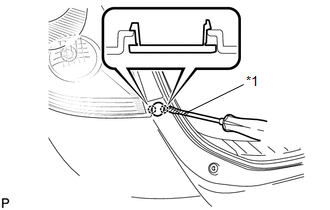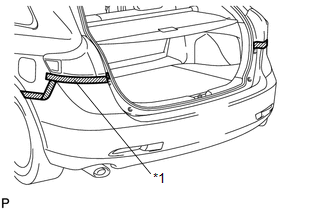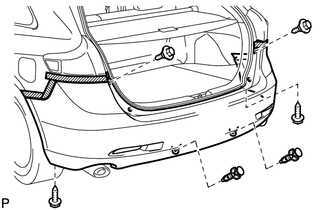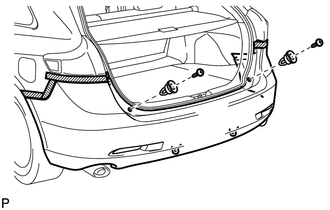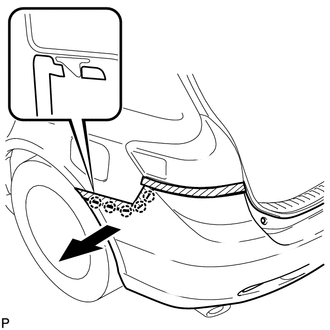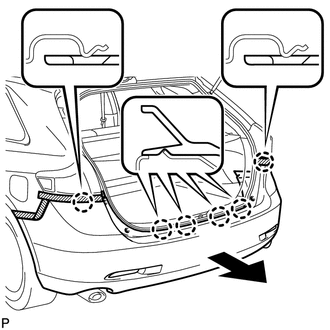Toyota Venza: Removal
REMOVAL
PROCEDURE
1. REMOVE REAR BUMPER PLATE LH
|
(a) Using a screwdriver with the tip wrapped with protective tape, disengage the 2 claws and remove the rear bumper plate LH. Text in Illustration
|
|
2. REMOVE REAR BUMPER PLATE RH
HINT:
Use the same procedure for the RH side and LH side.
3. REMOVE REAR BUMPER ASSEMBLY
|
(a) Put protective tape around the rear bumper assembly. Text in Illustration
|
|
|
(b) Remove the 2 bolts and 2 screws. |
|
(c) Using a clip remover, remove the 2 clips.
|
(d) Remove the 2 screws and 2 clips. |
|
|
(e) Remove the screw. HINT: Use the same procedure for the RH side and LH side. |
|
|
(f) Disengage the 5 claws. HINT: Use the same procedure for the RH side and LH side. |
|
|
(g) Disengage the 6 claws as shown in the illustration. |
|
(h) w/ Intuitive Parking Assist System:
(1) Disconnect each connector.
(i) Remove the rear bumper assembly.
 Components
Components
COMPONENTS
ILLUSTRATION
ILLUSTRATION
ILLUSTRATION
ILLUSTRATION
...
 Disassembly
Disassembly
DISASSEMBLY
PROCEDURE
1. REMOVE ULTRASONIC SENSOR CLIP (w/ Intuitive Parking Assist System)
2. REMOVE NO. 1 ULTRASONIC SENSOR (w/ Intuitive Parking Assist System)
3. REMOVE NO. 1 ULTRASONIC ...
Other materials about Toyota Venza:
On-vehicle Inspection
ON-VEHICLE INSPECTION
PROCEDURE
1. INSPECT ENGINE COOLANT
See page
2. INSPECT ENGINE OIL
See page
3. INSPECT BATTERY
See page
4. INSPECT AIR CLEANER FILTER ELEMENT SUB-ASSEMBLY
(a) Remove the air cleaner filter element sub-assembly.
(b) Visuall ...
System Description
SYSTEM DESCRIPTION
1. NAVIGATION SYSTEM OUTLINE
(a) Vehicle position tracking methods
It is essential that the navigation system correctly tracks the current vehicle
position and displays it on the map. There are 2 methods to track the current vehicle
p ...
Lost Communication with Clearance Warning ECU (U1110)
DESCRIPTION
DTC Code
DTC Detection Condition
Trouble Area
U1110
No communication from the clearance warning ECU assembly continues.
Clearance warning ECU assembly branch wire o ...
0.1228

